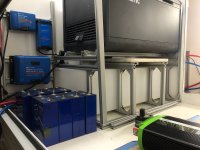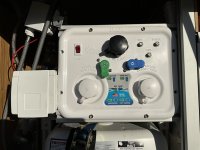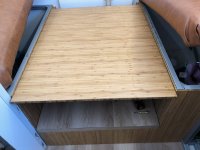HVAC
I used a
12 volt minisplint from Amazon. It was variously branded as AC/DC, Solar Velo, or Fleet Welcome. I can confirm they are all the same company (spoke w/ who I think is the only employee lol) and appear to be the same unit that AT is using in their Aterra. It isn’t available on Amazon now. Buying it was a classic pandemic-era waiting game.
It works great in both heating and cooling modes. It was pretty easy to install; I had custom hoses made that were shorter and higher quality. Bleeding the system was easy although I did have to buy a vacuum pump to make it happen.
On startup, it draws about 600w; once the temperature is achieved, it uses ~300w intermittently. It only uses a handful of watts on idle between cycles while the interior unit’s fan blows. In the summer sun, it will keep the interior cold indefinitely and uses no net power. Overnight, we have rarely needed it thus far - on the rare occasions we’re stuck somewhere hot, we use 60-120aH of power overnight; this was replenished in the first 3 hours of sunlight the next day.
The instructions are somewhat limited, especially for the remote. I got separate remote instructions from the company.
Its biggest con is that it is loud. When the system is at max output (heating or cooling), the exterior compressor is as loud as a cheap residential unit; the interior is as loud as a MaxAir fan on high. It isn’t the worst but I wouldn’t run around other campers.

Exterior unit.

The way the line set is routed makes a big mess in the interior

I’m still working on a solution for these exposed lines. Ideas appreciated.
Overall, the mini split is great. The fan power of the interior unit is somewhat limited (at least in our setup) at getting air from one end to the other; basically, that means the breeze at the far end of the cab over is pretty mild, even on high fan speeds.
The fact that I didn’t have to mount on the roof is super helpful. I’d buy it again; the
Crusin’ Comfort is really the only alternative. The loss of the heating function on the Crusin’ Comfort units isn’t as big of a deal as I imagined since solar is so limited in the winter, relying on a minisplit for heat is not the best option. Otherwise, the fact that they are made in the US out of bombproof materials makes them pretty appealing.
Since the mini split wouldn’t be the best way to heat in the winter, there is also a Planar diesel heater mounted in the front wall. I used a Rotopax as its tank and mounted it on the outside of the front wall.

As seen above, I’m using Planar’s PU-28 controller. It seems crazy to me that there is no thermostatic control of this device. According this video at 1:32, it sounds like enabling “ventilate in standby mode” allows this very thing:
I can confirm that this is partially true - in this mode, if the camper is warmer than the set point, the heater will automatically turn on once the temp has dropped, cycle, and turn back off. What is weird is that it only seems to do it once, eg - turn on once the temp drops below the set point, heats back up to the set point, cycles off, and then…nothing. The fan just blows ambient air. In addition, when it is in Fahrenheit mode, the displayed temp is up to 10 degrees off. In Celsius mode, the panel reads the same as every other thermometer. Another frustrating thing is that the heater responds to the setup when it varies by 3 degrees - kind of a wide range, especially in such a small space.





































